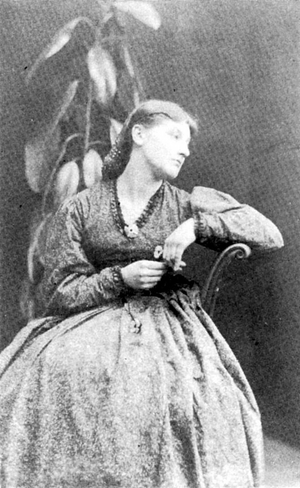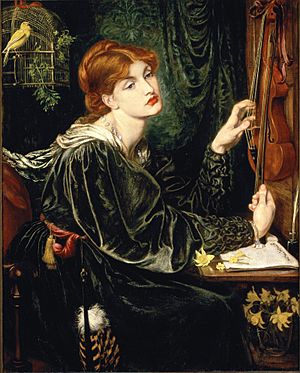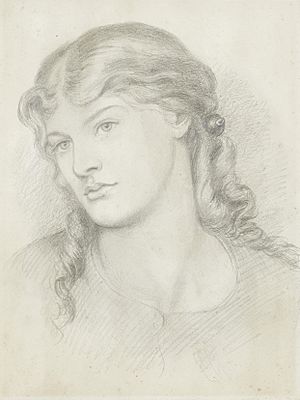Alexa Wilding facts for kids
Quick facts for kids
Alexa Wilding
|
|
|---|---|
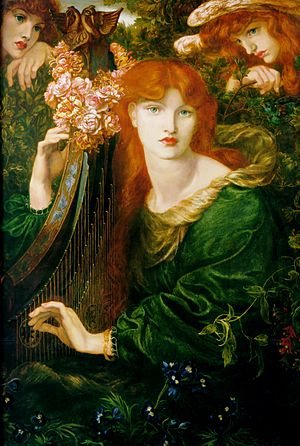
La Ghirlandata (1873) modelled by Alexa Wilding, by Dante Gabriel Rossetti
|
|
| Born |
Alice Wilding
1847 Surrey, England
|
| Died | 25 April 1884 (aged 36–37) London, England
|
| Nationality | English |
| Known for | Model (art) |
|
Notable work
|
Portrayed by Rossetti many times, 1860s and 1870s. |
| Movement | Pre-Raphaelites |
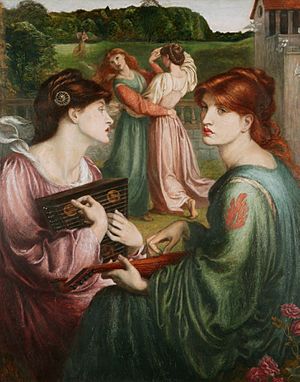
Alexa Wilding (born Alice Wilding, around 1847 – April 25, 1884) was a very important model for a famous artist named Dante Gabriel Rossetti. She posed for many of his best paintings in the 1860s and 1870s. She actually appeared in more of his finished artworks than other well-known models like Elizabeth Siddall, Jane Morris, and Fanny Cornforth.
Not as much is known about Alexa Wilding compared to Rossetti's other models, who are often written about.
Contents
About Alexa Wilding
Her Early Life
Alexa Wilding, whose real name was Alice, was born around 1847 in Surrey, England. Her family came from Shrewsbury, and her father made pianos. Her uncles were butchers.
In 1861, when she was 14, Alexa lived in London with her grandmother, two uncles, and a cousin. She worked, but her life was not too difficult for that time. She could also read and write. Later, she lived with an aunt and worked as a dressmaker. She hoped to become an actress someday.
Working with Rossetti
Rossetti first saw Alexa Wilding in 1865 while she was walking in Strand. He was very impressed by her beauty. She agreed to pose for him the next day for a painting called Aspecta Medusa. However, she did not show up. It's possible she was worried about how people viewed models back then.
Weeks passed, and Rossetti had almost given up on his painting idea. But then he saw her again in the street! He quickly got out of his cab and convinced her to come straight to his studio. He paid her a weekly fee so she would only pose for him. He didn't want other artists to hire her.
They formed a lasting friendship. After Rossetti died in 1882, Alexa Wilding, even though she wasn't rich, traveled to place flowers on his grave.
In 1881, Alice Wilding, then 34, lived in Kensington, London, with her two young children, Charles and Nellie. Charles was born in 1876, and Eleanor in 1877. We don't know who their father was. By this time, Alexa had become a landlady and owned property. This was a big achievement for a working-class woman.
Her Death
Alexa Wilding died on April 25, 1884, at the age of 37. Her death certificate says she died from peritonitis, which is an infection in the stomach area. Sixteen months before, she had been diagnosed with a problem in her spleen. This illness might have been why she sometimes couldn't pose for Rossetti.
She is buried in Brompton Cemetery with her grandmother and niece. Her tombstone says she died on April 24, 1884, but her death certificate lists April 25.
Alexa in Rossetti's Art
In Rossetti's paintings, Alexa Wilding's elegant and almost magical beauty was different from his other model, Fanny Cornforth. Alexa's more refined face was used instead of Fanny's in paintings like Lady Lilith (1864–1868). This happened because the painting's owner thought the original face was too "earthy."
Similarly, the painting Venus Verticordia (1864–1868) was first modeled by a very tall cook. But Rossetti repainted it with Alexa Wilding's face in 1868. Rossetti seemed to think her features could show both goodness, like in Sibylla Palmifera, and badness, like in the paintings mentioned above.
People who knew Alexa had different ideas about her expressions. Rossetti's assistant, Henry Treffry Dunn, said she was "without any variety of expression." He felt she was like a Sphinx, waiting to be asked questions, and always gave a vague answer. But he also said she had a "deep well of affection" inside her calm outside.
However, the artist's brother, William Michael Rossetti, thought she could show "much varying expression." Dunn described Alexa as having "a lovely face, beautifully molded in every feature, full of quiet, soft, mystical rest." He said her look was perfect for some of Rossetti's ideas. He was amazed by her beautiful face and golden-red hair. It was exactly the type of face he had been searching for.
It's easy to spot Alexa Wilding's features in Rossetti's art. She had red hair, a long neck, perfect Cupid's bow lips, and softer eyes compared to Lizzie Siddall's famous heavy-lidded ones. However, in The Blessed Damozel, her features are less clear because Rossetti painted her with his late wife's eyes.
Also, two of Rossetti's paintings featuring Alexa are similar to ones originally modeled by his late wife, Lizzie Siddall: Regina Cordium and Damsel of the Sanct Grael. According to Rossetti's friend, the art critic Frederic George Stephens, "nothing he drew of her, diverse as the delineations were, seemed less than an exact likeness." This means every drawing of her looked exactly like her, even if they were different.
Paintings and Drawings of Alexa Wilding
Paintings by Rossetti
- Monna Vanna (1866)
- Regina Cordium (1866); a new version of his 1860 painting, which had been modeled by his wife Elizabeth Siddall.
- Sibylla Palmifera (1866–1870)
- Venus Verticordia (repainted 1867-1868; originally 1864–1866), repainted with Wilding's face when it didn't sell.
- Dante's Dream at the Time of the Death of Beatrice (1871), far left.
- The Bower Meadow (1871–1872)
- Veronica Veronese (1872)
- Lady Lilith (repainted 1872-1873; originally 1864–1868), originally modeled by Fanny Cornforth, but repainted with Wilding's face.
- La Ghirlandata (1873)
- The Beloved (retouched in 1873; originally 1863), also thought to be inspired by Wilding when retouched.
- Damsel of the Sanct Grael (1874)
- Roman Widow (1874)
- La Bella Mano (1875)
- A Sea-Spell (1875-1877)
- The Blessed Damozel (1875–1878); shows the influence of his next muse Jane Morris's hooded eyes.
Drawings by Rossetti
- Portrait of Alexa Wilding (1865)
- Sibylla Palmifera (Study) (around 1866)
- Aspecta Medusa (around 1867)
- Mary Magdalene (1867)
- Rosa Triplex (1867), center.
- Venus Verticordia (Study) (1867-68)
- Study for ′La Pia de′ Tolomei′ (1868)
- Alexa Wilding, A Study for Dante's Dream (1870)
- Study for "Dante's Dream": Head of Alexa Wilding (1870)
- Lady Lilith - Study for the Head (1872-1872)
- Alexa Wilding (1874)
- Study for ′La Bella Mano′ (1875)
- Alexa Wilding (1879)


